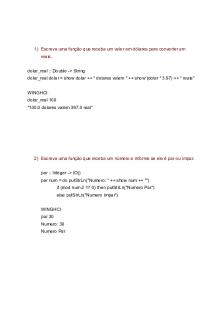2 - Haskell, Jeremy Jacobs PDF

| Title | 2 - Haskell, Jeremy Jacobs |
|---|---|
| Author | William Macleod |
| Course | Implementation of Programming Languages |
| Institution | University of York |
| Pages | 2 |
| File Size | 36.1 KB |
| File Type | |
| Total Downloads | 3 |
| Total Views | 155 |
Summary
A less concise but more detailed set of notes of the lecture conducted by Jeremy Jacobs, got me 81/100 in the exam...
Description
2 - H%skell H%skell is % l%ngu%ge which m%kes it very e%sy to m%nipul%te strings %nd trees strings %re the concrete represent%tion of our progr%m typic%lly strings %re ch%r%cters, %nd we %re going to turn these strings of ch%r%cters into %bstr%ct synt%x trees H%skells l%ziness is v useful bec%use it lets us de%l with unbounded, infinitely long objects, %s long %s we only look %t % finite p%rt l%ter when we look %t optimis%tion, one of the optimis%tion techniques, we do % list of %pproxim%tions, %nd find %long this list, the %pproxim%tion we w%nt. the synt%x %nd type system helps us %void errors in h%skell %nd h%skell supports the technique of synt%x-direct progr%mming, useful for %n%lysing %bstr%ct synt%x trees H%skell progr%ms consist of expressions, which %re to be ev%lu%ted, such %s below t"ke four (filter is_even (m"p (*3) [0…])) — — [0, 6, 12, 18] if its in bold, it is % st%nd%rd function th%t is defined for us we t%ke the first four items, t%kes four things off the list which we get by filtering %nother list with the predic%te is_even, so only t%kes even numbers %nd the other list to be filtered is the list by m%pping the function (*3) over the infinite list which st%rts %t 0, %nd continues to infinity ([0…]) H%skell lets us do th%t bec%use its l%zy, it wont exp%nd this infinite list unless needed, however bec%use weʼve st%ted only four %re needed, it will stop exp%nding once four h%ve been done when writing definitions, you donʼt need to give % type in H%skell True ‘impliesʼ F%lse = F%lse _ ‘impliesʼ _ = True Donʼt h%ve to fill in the other 3 versions for implies, they %ll imply true H%skell is polymorphic for %n empty list, H%skell for most of the time will be %ble to work out its type ——— St%tic & Dyn%mic sem%ntics going to use form%l logic to describe how to build % type checker
the fin%l p%rt of the %n%lyse st%ge in the front end of % compiler is c%lled the st%tic sem%ntics, %ll of which is type checking why do we c%re %bout me%nings? bec%use we w%nt to get %ccess to % progr%ms me%ning two types of me%ning: – st%tic me%ning: ones th%t c%n be determined without executing the progr%m – dyn%mic me%ning: ones th%t c%n only be determined by executing the progr%m the st%tic sem%ntics lets us detect type errors, helps us spot errors the dyn%mic sem%ntics help us define wh%t we me%n by % compiler, %nd use this to help us design tests for the compiler —— proof rules this is the synt%x of % proof rule
n%me
Existing Judgement 1 … Existing Judgement n New judgement
[side conditions=
They %ll h%ve n%mes so we c%n refer to them the line is % node of % tree %bove the line %re things th%t h%ve been s%id to be true, they %re true judgements the bottom line is the new judgement th%t we h%ve come to on the f%r right,...
Similar Free PDFs

2 - Haskell, Jeremy Jacobs
- 2 Pages

Haskell Tests
- 1 Pages

Função em Haskell - Básico
- 2 Pages

Haskell Cheat Sheet
- 13 Pages

Haskell function library
- 1 Pages

Lab Haskell - Ernesto Gomez
- 2 Pages

Estates (Jacobs) - 2018
- 71 Pages

Jacobs 16e SM Chap021
- 25 Pages

Pata de mono jacobs
- 11 Pages

Utilitarianism- Jeremy Bentham
- 5 Pages

Biografía Jeremy Rifkin
- 2 Pages
Popular Institutions
- Tinajero National High School - Annex
- Politeknik Caltex Riau
- Yokohama City University
- SGT University
- University of Al-Qadisiyah
- Divine Word College of Vigan
- Techniek College Rotterdam
- Universidade de Santiago
- Universiti Teknologi MARA Cawangan Johor Kampus Pasir Gudang
- Poltekkes Kemenkes Yogyakarta
- Baguio City National High School
- Colegio san marcos
- preparatoria uno
- Centro de Bachillerato Tecnológico Industrial y de Servicios No. 107
- Dalian Maritime University
- Quang Trung Secondary School
- Colegio Tecnológico en Informática
- Corporación Regional de Educación Superior
- Grupo CEDVA
- Dar Al Uloom University
- Centro de Estudios Preuniversitarios de la Universidad Nacional de Ingeniería
- 上智大学
- Aakash International School, Nuna Majara
- San Felipe Neri Catholic School
- Kang Chiao International School - New Taipei City
- Misamis Occidental National High School
- Institución Educativa Escuela Normal Juan Ladrilleros
- Kolehiyo ng Pantukan
- Batanes State College
- Instituto Continental
- Sekolah Menengah Kejuruan Kesehatan Kaltara (Tarakan)
- Colegio de La Inmaculada Concepcion - Cebu




